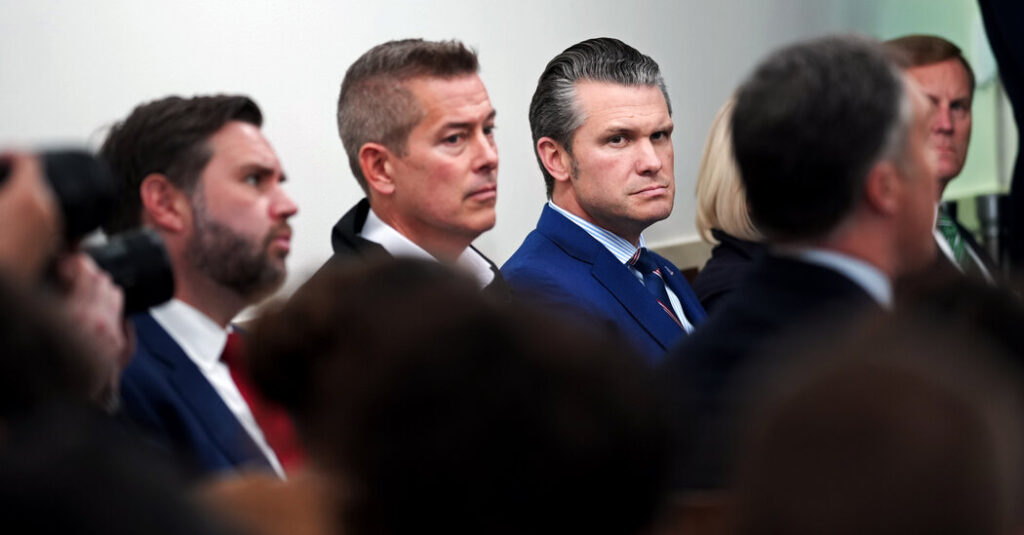The White House effort to defend Defense Secretary Pete Hegseth on Wednesday leaned heavily into a semantic argument. What he posted on the now-infamous Signal chat with his national security colleagues was not a “war plan,” they insist.
Technically, they may be right. What The Atlantic published, from the chain in which its top editor, Jeffrey Goldberg, was inadvertently included, is more like a timeline of a pending attack. But it is so detailed — with the time that F/A-18F Super Hornet jets were supposed to launch and the time that MQ-9 Reaper drones would fly in from land bases in the Middle East — that the answer may prove a distinction without a difference.
A full “war plan” would undoubtedly be more specific, with the routings of weaponry and coordinates for targets. But that is not likely to help the defense secretary as he tries to explain away why he put these details on an unclassified commercial app that, while encrypted, was far from the heavily protected, classified internal systems used by the Pentagon.
And it was the time stamps he included in his messages, hours before the attack began, that were critical: Had this information leaked out, the Houthi fighters and missile experts the United States was targeting in Yemen would have had time to escape. Mr. Hegseth’s own references in the Signal chain to “OPSEC” — or operational security — indicated he fully understood the need to keep this timing secret.
And the level of detail was striking: “1215et: F-18s LAUNCH (1st strike package),” Mr. Hegseth wrote in the chat. “1345: “Trigger Based” F-18 1st Strike Window Starts (Target Terrorist is @ his Known Location so SHOULD BE ON TIME) – also, Strike Drones Launch (MQ-9s).”
Clearly this is the most sensitive of battlefield plans. National security veterans say it was almost certainly classified data at the time that Mr. Hegseth sent them to the group chat. Yet the question of classification has been at the heart of the Trump administration’s explanations for why the Signal chat was a minor transgression.
“So this was not classified,” Mr. Trump insisted during a meeting with U.S. ambassadors at the White House on Tuesday. “Now if it’s classified information, it’s probably a little bit different, but I always say, you have to learn from every experience.”
The White House and national security officials will not say who declassified the data or, crucially, whether they did so after the attack was over.
“It’s by the awesome grace of God that we are not mourning dead pilots right now,” Rep. Jim Himes of Connecticut, a Democrat, said at a hearing Wednesday morning with top intelligence officials.
None of that deterred Karoline Leavitt, the White House press secretary, from making the case that Mr. Hegseth, a former National Guard infantryman and television commentator who has made a series of missteps in his first two months in office, did not reveal a “war plan.”
“The Atlantic has conceded: these were NOT ‘war plans,’” Ms. Leavitt wrote on X. “This entire story was another hoax written by a Trump-hater who is well-known for his sensationalist spin.”
Leaving aside her attacks on Mr. Goldberg, who has covered national security affairs for several decades, Ms. Leavitt’s blast was openly contradicted by the director of the C.I.A., John Ratcliffe, in testimony in front of a Senate committee on Tuesday.
He acknowledged that the Signal chain, in which he was a participant, was real, and Mr. Goldberg’s description of it was accurate. Tulsi Gabbard, the director of national intelligence, who at first tried to evade questions about the Signal chain, later agreed, once Mr. Ratcliffe confirmed his participation.
Both said the information was not classified. But when pressed, they amended their comments to say there was no classified intelligence information in the chat — meaning they were not commenting on whether there were classified Pentagon operational plans.
But to truth-test their comments, consider this one, common-sense test: Had a news organization gone to the Pentagon or the National Security Council before the attack, and said it was considering publishing this kind of timing and detail, would the administration have asked it to withhold the information because it could have compromised the attack? Or because it could have put American pilots at risk if the Houthis, with their missile capabilities, knew they were coming?
The administration almost certainly would have asked them not to publish — and most responsible news organizations would have held that data back, at least until the attack was over. It is a scenario that has played out many times in the past few years, involving everything from operations in Afghanistan and Iraq to attacks on Syrian and Iranian sites.
All of which makes it all the more mystifying that more than 18 Trump administration officials discussed that timing on a commercial if encrypted app, whose servers are outside the United States.
https://www.nytimes.com/2025/03/26/us/politics/hegseth-signal-war-plan-leak-white-house.html


